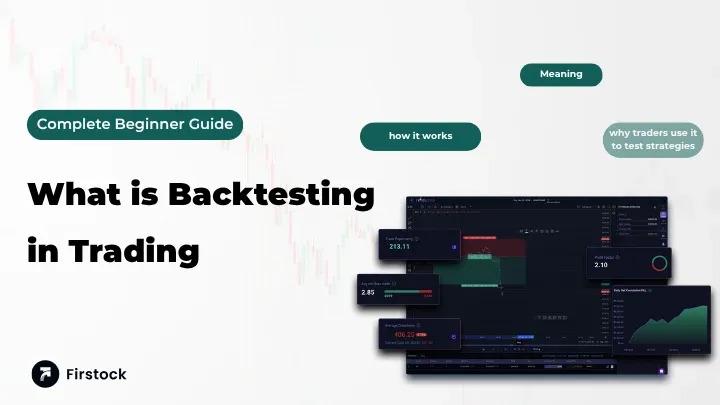Back Testing Strategies in Trading – Complete Beginner’s Guide

Back Testing Strategies: The Ultimate Guide for Traders
Introduction
Have you ever wished you could test your trading strategy before putting real money on the line? Imagine being able to travel back in time to see how your trades would have performed in the past. That’s exactly what back testing allows you to do!
In the world of trading, back testing in trading is like a “time machine” that helps you test your ideas using historical data — before risking a single rupee. It’s one of the smartest ways to learn, refine, and perfect your trading approach.
In this article, we’ll explore what is back testing intrading, how to build effective back testing strategies, and how you can use a trading app in India to do it with ease.
Discover what is back testing intrading, best back testing strategies, and how to use a trading app in India for successful back testing intrading.
What is Back Testing in Trading?
Back testing in trading is the process of applying your trading strategy to past market data to see how it would have performed.
Think of it like “replaying” the market. You input your buy and sell rules into a system, and it tells you what would have happened — how much profit or loss you’d have made, how many trades succeeded, and what your overall performance was.
In simple terms, back testing helps you answer the question: “If I had traded this way before, would I have made money?”
Why is Back Testing Important?
Why jump into a river without knowing its depth? The same logic applies to trading.
Back testing allows traders to:
-
Evaluate performance: You can see if your strategy has potential.
-
Build confidence: Knowing your plan works helps you trade calmly.
-
Improve consistency: Back testing removes emotional decision-making.
-
Understand risk: You can identify how much you might lose in bad markets.
By using back testing intrading, you avoid making blind guesses and start making data-driven decisions.
How Does Back Testing Work?
The process of back testing usually follows these steps:
-
Choose a strategy – For example, “Buy when the price crosses above the 50-day moving average.”
-
Select historical data – Pick a time period (say, 2018–2023).
-
Run the test – Apply the rules to past data using software or a trading app.
-
Analyze the results – Review profit, drawdown, win/loss ratio, etc.
If the strategy shows promise, it can then be optimized further or even used in live trading.
Key Elements of a Good Back Test
A strong back test depends on these key elements:
-
Quality Data: The more accurate and detailed your market data, the better.
-
Realistic Assumptions: Include brokerage fees, slippage, and order delays.
-
Consistent Rules: Avoid changing your strategy midway through the test.
-
Statistical Depth: Use enough data to cover various market conditions.
A good back test should mirror real trading as closely as possible.
Types of Back Testing Strategies
Let’s look at some common back testing strategies traders use:
a. Technical Indicator Strategies
Use moving averages, RSI, MACD, and other tools to generate buy/sell signals.
b. Price Action Strategies
Focus on price movements, patterns, and candlestick behavior without indicators.
c. Fundamental Back Testing
Tests strategies based on earnings reports, news, or macroeconomic data.
d. Quantitative or Algorithmic Testing
Mathematical models or codes test thousands of trades using automation.
e. Portfolio-Level Back Testing
Tests how a group of assets (like stocks or ETFs) perform together.
Each of these strategies can be adapted to your trading goals and style.
Manual vs Automated Back Testing
There are two main approaches:
Manual Back Testing
You go through charts manually, marking where you’d buy or sell.
-
Pros: Great for learning price patterns.
-
Cons: Time-consuming and prone to human error.
Automated Back Testing
Software runs the test automatically using algorithms.
-
Pros: Fast, accurate, and scalable.
-
Cons: Requires coding knowledge or advanced tools.
Most traders today prefer automated back testing using a trading app in India that supports historical simulations.
Common Mistakes in Back Testing
Even the best traders make mistakes while back testing. Watch out for these:
-
Overfitting: Designing a strategy that works only for past data but fails in live markets.
-
Ignoring Costs: Forgetting to include brokerage and slippage.
-
Small Sample Size: Testing on too little data gives misleading results.
-
Changing Rules Midway: Inconsistent testing leads to false outcomes.
Remember, the goal isn’t to create a perfect past performance — it’s to build a reliable future strategy.
How to Create a Back Testing Plan
Here’s a simple roadmap for building your back testing plan:
-
Define Objectives: Are you testing for profits, stability, or risk?
-
Set Clear Rules: Decide exactly when to buy and sell.
-
Collect Data: Use at least 3–5 years of market data.
-
Choose Software or App: Pick a reliable trading app in India.
-
Run and Record Results: Note profits, drawdowns, and win rates.
-
Refine and Retest: Adjust the strategy and test again.
A structured plan ensures your back testing remains consistent and trustworthy.
Best Tools and Trading Apps in India for Back Testing
If you’re in India, you’re in luck! Many trading apps in India offer back testing features. Here are some top picks:
-
TradingView: Popular for chart-based back testing and strategy simulation.
-
Firstock: A growing trading app in India with powerful back testing and execution tools.
-
Upstox Pro: Offers back testing options for technical strategies.
-
Zerodha Streak: Enables automated back testing without coding.
-
MetaTrader 5: Ideal for algorithmic back testing.
Choose a platform that fits your style — whether you prefer visual charts or automated scripts.
How to Analyze Back Testing Results
After back testing, don’t just look at profit numbers. Dive deeper:
-
Win Rate: Percentage of successful trades.
-
Profit Factor: Total profit divided by total loss.
-
Maximum Drawdown: Largest drop from a peak to a trough.
-
Sharpe Ratio: Measures returns relative to risk.
-
Equity Curve: Visual representation of growth over time.
A profitable back test should show stable, consistent growth — not wild ups and downs.
Advantages of Back Testing in Trading
Some of the biggest benefits of back testing intrading include:
-
Confidence Boost: You’ll know your strategy works before investing.
-
Objective Decision-Making: Removes emotions like fear or greed.
-
Efficiency: Saves time by eliminating weak ideas quickly.
-
Better Risk Control: Understand potential losses before trading live.
In short, back testing makes you a smarter, calmer, and more disciplined trader.
Limitations of Back Testing
However, back testing isn’t a crystal ball. It has its limits:
-
Past ≠ Future: Markets change, and old data can mislead.
-
Data Errors: Inaccurate data can produce false results.
-
Ignoring Market Sentiment: Emotions and news can’t be back tested.
-
Over-Optimization: A perfect historical fit may fail in reality.
Always treat back testing as a guide, not a guarantee.
Back Testing vs Paper Trading
While they sound similar, there’s a difference:
-
Back Testing: Tests strategies using past data.
-
Paper Trading: Tests strategies in real time using fake money.
Both are valuable. You can start with back testing to identify good strategies, then use paper trading to validate them in live conditions.
Tips for Successful Back Testing
Here are some pro tips to get the most out of your back testing strategies:
-
Use Long-Term Data: Test across different market cycles.
-
Avoid Over-Optimization: Keep rules simple.
-
Incorporate Real Costs: Include brokerage and taxes.
-
Test Multiple Assets: See how your strategy performs across markets.
-
Review Periodically: Update your strategy as market conditions evolve.
Like tuning a car before a race, these steps help your strategy run smoothly.
Final Thoughts and Conclusion
Back testing is the training ground of successful traders. It’s your opportunity to learn from history without losing money. Whether you’re a beginner or an experienced investor, mastering back testing intrading will sharpen your trading edge.
With the right back testing strategies and a reliable trading app in India, you can build confidence, minimize risk, and make smarter decisions in the stock market.
So before your next trade — take a step back, test it, and trade smart!
Frequently Asked Questions (FAQs)
1. What is back testing intrading?
Back testing intrading means testing your trading strategy on past data to see how it would have performed historically.
2. Can I do back testing on my phone using a trading app in India?
Yes! Many trading apps in India like Zerodha Streak, Firstock, and TradingView allow mobile back testing.
3. How accurate is back testing in trading?
Back testing is reliable when you use quality data and realistic assumptions, but results may differ in live markets.
4. What is the difference between back testing and paper trading?
Back testing uses historical data, while paper trading tests your strategy live with virtual money.
5. Which are the best back testing strategies for beginners?
Start with simple moving average crossovers, RSI-based strategies, or breakout methods — easy to understand and test.





